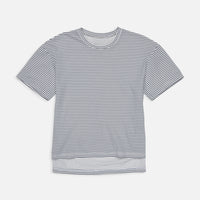Material Guidelines
Natural Fibers
Natural fibers represent the most common fibers in our collections. Producing materials has a high environmental impact. By using deadstock, we do not contribute to the environmental impact tied to the production of the material.
Cotton
Cotton is the most used plant-based fiber. Its extensive use is reflected in its environmental impact, which mainly lies in its production. To grow cotton, extensive amounts of water and chemicals are needed, impacting the soil where it’s grown as well as local communities. Additionally, cotton production contributes to the pollution of waterways. Meanwhile, social implications are in the commerce around the fiber and the labour involved. We always prefer to source excess cotton, which would otherwise be wasted. When sourcing virgin, we ensure the cotton we use was ethically produced without the use of hazardous chemicals and also in compliance with strict local legal environmental and social standards.
Linen
Linen is a plant fiber originating from the flax plant. Its properties, such as biodegradability, make it a less impactful material than others. However, it still comes with an environmental footprint due to water and pesticide usage. Additionally, due to the dense nature of the fiber, it requires a significant amount of chemicals to dye the fabric, particularly to get that fresh white linen look. All the linen sourced for our collection comes from excess stock therefore we do not use virgin linen fibers.
For natural, animal-based fibers, please refer to our Animal Welfare Commitment here.
Synthetic Fibers
With polyester being the most common fiber used in the textile industry, synthetic excess fabric is widely available. Synthetic fibers, when discarded, represent a real threat to biodiversity. Diverting such waste from landfill reduces its overall environmental impact. We tend to use this fiber for outerwear as its durability limits the garment’s need for laundering, thereby reducing the impact of plastic pollution. In most all cases, we are using excess stock for textiles with synthetic fibers. Please refer to our product care to learn how to take the best care of your clothes.
Polyester
Polyester is a man-made fiber derived from oil. It is one of the most common fibers in the world and the one with the largest environmental footprint. Its main impact relates to raw material extractions and depletion, microplastic release through laundering, and biodegradability issues at the end of life. Additionally, it carries social impact linked to occupational health and safety risks during production, the contamination of local air, water, and soil, and the absorption of residual chemicals caused through wear.
Nylon
Nylon is a manufactured synthetic fiber and it belongs to the polymer family. Like all oil-based fibers, nylon’s impact is linked to the depletion of limited resources, such as oil and water. Its environmental footprint is also related to the emission of GHGs.
When sourcing Nylon, our chosen alternatives are certified recycled fibers such as REPREVE®.
Cellulosic Fibers
Cellulosic fibers are produced from wood. The main issue with these fibers is the way they are processed, whether chemically or mechanically. The chemical process, which is the most common, has a higher environmental impact. These fibers perform similarly to synthetics. They can be a better option, particularly when sourced from excess materials.
Viscose/Rayon
Viscose/Rayon is a manufactured cellulosic fiber derived from wood pulp, typically made of wood from eucalyptus, spruce and pine trees. It can also be made from cotton or bamboo. Its impact is related to the chemical substances commonly needed to transform the pulp into fiber. Virgin viscose is never featured in our collection, all the cellulosic fibers we use are from excess materials.


